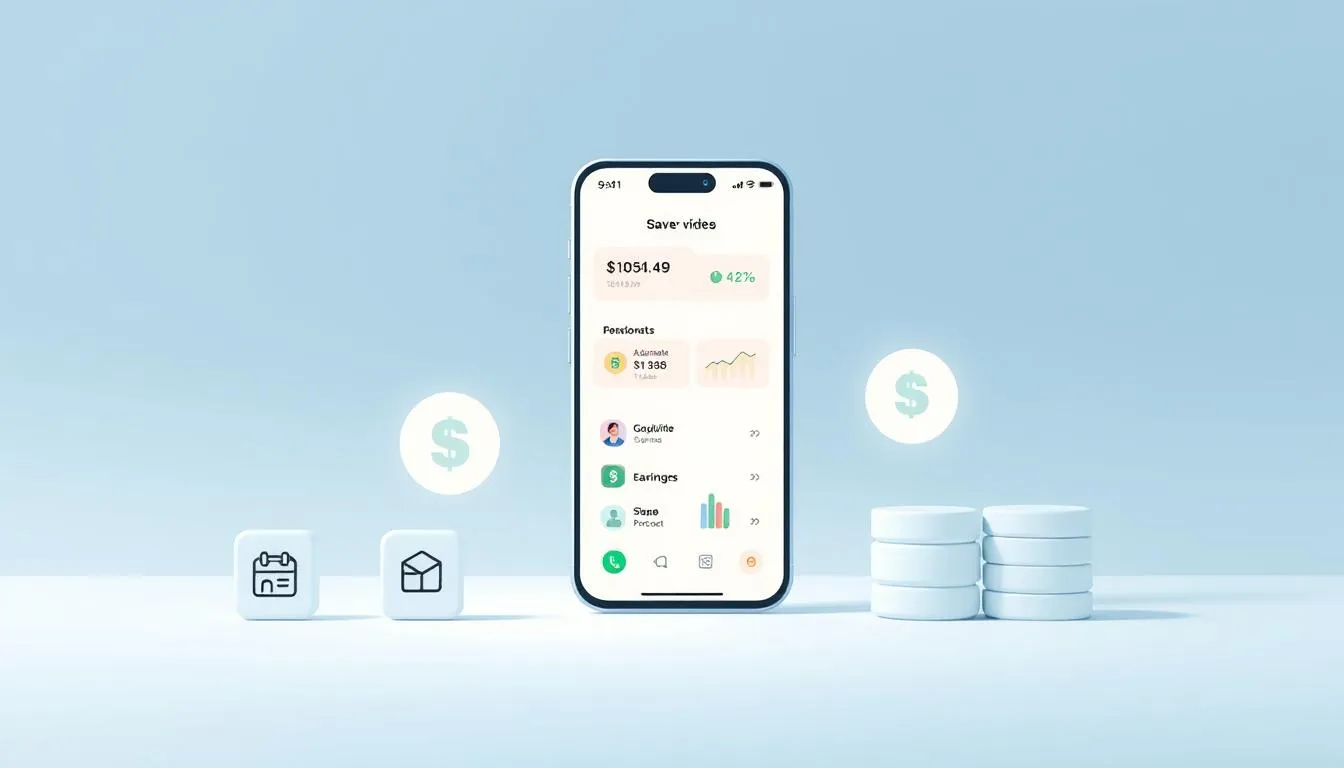Surprising fact: one app called Money Manager Expense & Budget has 20 million+ downloads, 270,000 reviews and a 4.7 average rating an Editors Choice on Google Play.
This scale shows how apps can centralize your finances. Todays best tools bring budgeting, tracking, and savings into one place so you spend less time worrying and more time reaching goals.
We focus on a product-centered comparison that highlights concrete features and verified ratings. That helps shoppers shortlist an app that fits daily needs fast. For those looking to automate their savings alongside budget tracking, see our guide to savings automation that can simplify your financial future.
Look for a balance of ease-of-use and pro tools: category-level budget control, calendar views, charts, receipt capture, and double-entry accuracy. These traits drive real savings for many users.
Well also cover multi-account and multi-currency support, secure data sync (notes: Data Sync is $2.49/month or $19.99/year), and plan pricing so you can match cost to benefit. For comprehensive subscription management strategies, explore our analysis of subscription-based financial tools that simplify your finances. For a broader list of top options, see this guide from best budgeting apps.
Key Takeaways
- High install counts and solid ratings signal reliability and ongoing updates.
- Top apps combine simple setup with pro-grade controls for clear cash flow.
- Receipt capture and double-entry bookkeeping improve accuracy and trust.
- Check multi-currency and multi-account support if you juggle different funds.
- Compare sync subscription costs to expected time savings and security benefits.
Why a money manager app is your shortcut to smarter finances
The right app surfaces daily trends and calendar views so your budget actually fits your life.
U.S. shoppers value tools that cut routine work and save time. Automated quick-add entries, reinforced filters, and a built-in calculator remove friction. That leaves users with clear weekly, monthly, and annual statistics to act on.
Calendar-driven visuals make it simple to spot high-spend days and rebalance before month-end. Flexible month-start dates and recurring schedules align plans with payroll and bill cycles.

- Fast setup and intuitive controls help new users begin tracking in minutes.
- Day-by-day totals and clean summaries make course-correcting easy.
- Search and reinforced filters let you answer where did my money go? instantly.
For a quick test drive, try the Spending Tracker app to see calendar summaries, flexible month starts, and robust filters in action.
Featured pick: Money Manager Expense & Budget trusted by millions
This app combines polished visuals with robust accounting so daily tracking becomes routine. Backed by 20M+ downloads, about 270K reviews, and a 4.7 average, it earned Editors Choice on Google Play.

What users say: real examples of savings and better budgeting
Users report fast setup, clear charts, and category budgets that show spending leaks. One example: a user lowered dining-out limits and saw steady savings over months and years.
“Recurring settings for weekly or biweekly bills fixed my cash flow. Transfers between accounts now match reality without duplicate entries.”
Light and dark modes with improved charts and visuals
Key features include advanced category planning, improved calendar views, asset graphs, reinforced filters, photo receipt save, and double-entry bookkeeping behind the scenes.
- Find transactions in seconds with smart search and filters.
- Accurate balances across cash, debit, and credit without extra work.
- Community requests (split transactions, color-coding) show active refinement.
Version 2.12.1 (Jul 21, 2025) fixed bugs and boosted performance so tracking takes less time and feels snappier.
Money manager features that actually help you save
A practical feature set should nudge better choices without adding more work to your day.
Advanced budget planning per category with weekly, monthly, and annual views
Set precise limits per category and view progress by week, month, or year. Change the month start date to match pay cycles so totals reflect your cash flow.
Improved calendar to track daily, weekly, and monthly transactions
The calendar groups transactions by day and week. That makes it easy to spot patterns that inflate expenses and to pace spending before month-end.
Double-entry bookkeeping for accurate account management
Automatic double-entry bookkeeping keeps balances consistent across accounts. Reconciliations are faster and errors drop, so statements match reality.
Asset graphs and charts to visualize expenses and trends over time
Improved charts turn numbers into clear visuals. Asset graphs show essentials versus discretionary spending at a glance and reveal long-term trends.
Filters and search to review transactions by account, recipient, or category
Reinforced filters and fast search answer targeted questions like which merchant or category causes overspending. Photo receipt save helps with returns, reimbursements, or taxes.

| Feature | What it does | Benefit | Best use |
|---|---|---|---|
| Category budgets | Weekly / monthly / annual limits | Fine-tune short- and long-term goals | Control dining, groceries, and subscriptions |
| Calendar view | Daily and weekly transaction rollups | Spot high-spend days fast | Pace spending across pay cycles |
| Double-entry bookkeeping | Auto-balanced ledger entries | Accurate balances and easy reconciliation | Track transfers and account accuracy |
| Filters & search | Sort by account, recipient, or category | Answer where did it go? quickly | Find merchant trends and reduce expenses |
These tools help you act on small habits that compound into real savings. For more app options and comparisons, see the best budgeting apps guide.
Accounts, currencies, and transactions made simple
Bring every checking, savings, loan, and investment account into a single view for clearer decisions.
Consolidate all account types cash, debit, credit, savings, loans, and investments so balances and categories match across your whole financial picture. This reduces blind spots and keeps reconciliation fast.
Connect debit cards to record spending automatically. Transfers between accounts are recorded as transfers, not duplicate expenses, so totals stay accurate without spreadsheets.
Multiple currencies and roll-up totals
Use per-account currency settings to track local spending while the app converts and rolls up totals to a preferred base. This helps travelers and expats see both local balances and an overall total in one place.
Speedy entries and better filters
Payment profiles save recurring purchases like utilities or subscriptions so logging takes seconds and information quality improves. Sort by recipient or filter by account to isolate problem areas and trim recurring expenses.
| Capability | How it works | Practical benefit |
|---|---|---|
| Unified accounts | Shows cash, bank, credit, savings, loans, investments | Fewer blind spots; consistent categories |
| Auto card connection | Debit card feeds post transactions automatically | Reduces missed entries; keeps expenses current |
| Multi-currency roll-up | Per-account currency with preferred base conversion | Clear totals for travelers and multi-currency users |
Security, identity, and data protection you can trust
Good security should be simple to use and easy to verify. Strong protections keep your sensitive information safe without adding friction to daily tracking.
Passcode protection and privacy practices
Passcode locks protect the app and the data it stores. You can choose how long the app waits before asking for re-authentication, from immediate lock to a brief delay.
Short timeouts reduce exposure if a device is lost. Longer delays cut repeated unlock steps when you check balances several times a day.
Published privacy policies spell out what types of dataidentifiers, usage data, and diagnosticsmay be collected. That helps you decide which features to enable.
Backup and restore via email, iTunes, and iCloud
Backups let you restore an account quickly after a device change or app reinstall. Options include encrypted email exports, iTunes file backups, and iCloud sync for seamless recovery.
Set a routine backup schedule and verify restores so your history and settings remain intact across devices and upgrades.
| Protection | How it works | Benefit |
|---|---|---|
| Passcode & timeout | Configurable lock interval and PIN/biometric unlock | Fast access with strong protection against unauthorized use |
| Privacy policy | Public disclosure of data types and practices | Clear choices about sharing features and risk |
| Backup options | Email export, iTunes backup, iCloud sync | Quick recovery and cross-device continuity |
Account-level safeguards plus regular backups mean you can focus on planning instead of loss or breaches. Set a short timeout and enable routine backups to keep your data private and recoverable in no time.
Money Manager pricing, purchase options, and data sync
Deciding on a sync plan is easier when you know costs, renewal rules, and what unlocks across devices.
Monthly and yearly subscriptions with auto-renew details
Prices: Data Sync is $2.49 per month (auto-renewing) or $19.99 per year (auto-renewing). Choose the yearly plan if you expect to use sync across multiple devices for several years.
Purchase flow: Payment is charged to your iTunes account after confirmation. Subscriptions auto-renew unless turned off at least 24 hours before the current term ends.
Manage renewals: You can disable auto-renew in Account Settings after purchase. Renewal charges occur within 24 hours before the period ends and show the cost.
What Data Sync unlocks: Reliable cross-device continuity keeps your latest entries synced to every account and device. The full version for iOS also removes ads, lifts the 10-account lite limit, and enables the PC manager via WiFi for desktop edits and richer graphs.
| Plan | Price | Best for |
|---|---|---|
| Monthly | $2.49 / month | Short-term use or trial |
| Yearly | $19.99 / year | Frequent syncing across devices over years |
| Full iOS version | One-time upgrade via app | No ads, more accounts, PC WiFi manager |
How to choose the right money manager for your budget
Choose a tool that gives you clear, action-ready data after a few days of use.
Start with goals. If you need strict envelope controls, prioritize category-based budgets with weekly and monthly targets that match your pay cycle.
Check visualization options. Calendars, charts, and asset graphs make it fast to spot trends and act mid-period.
Test portability and ease of use. Multiple currencies, seamless transfers, and debit card connections reduce friction when you travel or use several banks.
Verify accuracy under the hood. Double-entry bookkeeping and reconciliation tools keep balances reliable so you spend less time fixing errors.
Look for convenience extras like photo receipt capture, payment profiles, and robust search/filters. These speed daily logging and keep records tidy.
Security matters: ensure passcode control and dependable backup/restore so your history is safe and recoverable.
- Try a simple example: track dining, groceries, and transit for one week.
- See if the app turns entries into useful information and clear next steps.
- Keep the app only if it helps you meet goals with less effort.
| Selection factor | What to check | Why it matters | Quick test |
|---|---|---|---|
| Category budgets | Weekly/monthly limits and alerts | Enforces spending targets | Set three categories and watch totals for a week |
| Visualization | Calendar, charts, asset graphs | Speeds decisions mid-cycle | Open calendar view and spot a high-spend day |
| Accuracy & sync | Double-entry, auto transfers, backups | Reduces reconciliation work | Make a transfer and confirm one balanced entry |
| Convenience & security | Photo receipts, search, passcode, multi-currency | Makes daily tracking quick and safe | Save one receipt and restore backup |
Daily Money Manager vs. money manager apps: whats the difference?
Apps give insight and automation; a trusted professional steps in when hands-on bill pay and document work are needed.
Apps optimize tracking, charts, and automated reminders. They surface trends and offer useful features for everyday decisions. An app is fast, low-cost, and great for routine oversight.
When to hire a Daily Money Manager (AADMM) for bill pay and bookkeeping
Hire a DMM when you need hands-on help. AADMM members assist seniors, people with disabilities, busy professionals, high-net-worth clients, and small businesses. They handle bill pay, organize paper statements, and provide ongoing bookkeeping support.
Members follow ethical standards and continuing education. That gives extra reassurance when you trust someone with sensitive finances and multiple accounts.
Practical boundary: apps do not sort physical mail, negotiate bills, or attend meetings. A human provider does those tasks and coordinates caregivers or multiple account holders.
- Use an app for daily tracking and reports.
- Bring in a DMM for complex filing, deadlines, or when your time is limited.
- Combine both: keep digital records in the app while a DMM manages real-world tasks.
| Role | Primary tasks | Best when |
|---|---|---|
| App | Tracking, charts, alerts, auto-sync | You want low-cost, instant reports |
| Daily Money Manager | Bill pay, paperwork, bookkeeping, coordination | Physical mail, many accounts, caregiver involvement |
| Both | Shared records; pro oversight | When accuracy and time savings both matter |
Conclusion
A single app that centralizes accounts makes it easier to act on spending trends. ,
Let clear visuals and accurate ledgers do the heavy lifting. Our featured money manager stands out for credible ratings, category-based budgeting, double-entry accuracy, and asset charts that turn data into quick decisions.
Try this example: set three categories with weekly limits, enter transactions for seven days, and review charts to find easy savings wins before month-end.
When you purchase a sync plan, pick the cadence that fits your devices. Subscriptions can be managed in your account and cancelled before auto-renew.
Strong privacy, identity protection, and routine backups via email or cloud keep your history safe. Start today, stay consistent, and let modern tools make steady savings and smarter finance management less surprising. For those interested in exploring additional investment opportunities as savings grow, consider our guide to top micro-investing platforms for small investments.
FAQ
What are the top apps for budgeting and savings?
Popular choices include apps that offer category budgets, visual reports, and multi-account support. Look for features like calendar views, double-entry bookkeeping, and export options so you can track spending across cash, debit, credit, and savings accounts.
Why use a budgeting app instead of spreadsheets?
Apps automate categorization, show real-time balances, and provide insights with charts and alerts. They save time on bookkeeping and help you spot trends so you can adjust spending and boost savings faster than manual tracking.
What does trusted by millions mean for an app?
It means the app has large download numbers, many ratings, and consistent reviews. High installs and positive feedback signal reliability, frequent updates, and active support from the developer.
How do light and dark modes help with finances?
These modes improve readability across devices and reduce eye strain. Better visuals and clearer charts make it easier to interpret trends and make budget decisions, day or night.
What budgeting features actually help me save?
Useful features include per-category budgets, weekly/monthly/annual views, automated categorization, and alerts for overspending. Visuals like asset graphs and trend lines highlight where to cut costs.
How does a calendar view improve expense tracking?
A calendar shows when recurring bills and purchases occur, helping you plan cash flow. Its easier to spot high-spend days and align bill payments with paychecks to avoid late fees.
What is double-entry bookkeeping in a personal finance app?
Double-entry bookkeeping records both sides of a transactionwhere money came from and where it went. This improves accuracy, helps reconcile accounts, and makes tax time simpler.
Can I manage multiple account types in one app?
Yes. The best apps let you track cash, debit, credit, savings, loans, and investment accounts together, so you see a complete financial snapshot without switching tools.
Does the app support multiple currencies and transfers?
Many apps offer multi-currency support and internal transfers between accounts. This is useful for travelers or users with international accounts and investments.
How secure is my financial data in these apps?
Leading apps use passcode protection, encryption, and privacy policies to protect identity and data. Check for backup and restore options like email, iTunes, or iCloud for added redundancy.
What backup options should I look for?
Choose apps that provide encrypted backups and easy restore via email, iTunes, or cloud services. Local export (CSV/Excel) is a plus for long-term bookkeeping and tax records.
How do subscription and purchase options usually work?
Most offer monthly and yearly plans with auto-renewal. Some apps provide a free tier and a premium upgrade that unlocks advanced reports, multi-device sync, and priority support.
How do I pick the right app for my needs?
Prioritize features youll use: budgeting cadence (weekly vs. monthly), transaction search and filters, reporting, and backup methods. Read reviews, test free tiers, and confirm device compatibility before subscribing.
When should I hire a Daily Money Manager instead of using an app?
Hire a certified Daily Money Manager for hands-on bill pay, complex bookkeeping, or when you need someone to handle paperwork and liaise with creditors. Apps are great for self-service tracking and automated insights.
How do transaction filters and search help with budgeting?
Filters let you view transactions by account, recipient, or category, making it quick to audit spending, find specific purchases, and prepare reports for tax or planning purposes.
Can these apps improve my credit and savings goals?
While they dont change credit directly, apps help you schedule payments, avoid late fees, and allocate funds toward goals. Consistent tracking and automated savings rules support better financial habits over time.
Are there export options for accountants or tax prep?
Yes. Look for CSV, Excel, or PDF export features. These make it simple to share transaction histories and reports with bookkeepers, accountants, or tax services.
How do ratings and reviews influence my choice?
Ratings reflect user satisfaction, while reviews highlight strengths and issues. Pay attention to recent feedback about updates, customer service, and reliability when deciding.
What should I check about privacy before signing up?
Review the apps privacy policy, data encryption practices, and options to delete or export your data. Confirm whether data is shared with third parties and how identity protection is handled.
